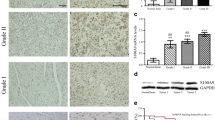Summary
This study examined the effect of small interfering RNA-mediated β-catenin knockdown on the survival, invasion and chemosensitivity of human osteosarcoma cells (U2-OS cells). The siRNA against β-catenin was constructed and transfected into U2-OS cells. The expression of β-catenin was detected by qRT-PCR and Western blotting. Cell growth and apoptosis was detected in the presence or absence of doxorubicin by MTT and flow cytometry, respectively. Cell invasion ability was measured by transwell assay. The results showed that the transfection of β-catenin siRNA resulted in decreased expression of β-catenin, suppression of invasion and motility of U2-OS cells, reduced chemosensitivity to doxorubicin in vitro, and little change in cell growth and apoptosis. Additionally, down-regulated MT1-MMP expression was found after transfection. It was concluded that knockdown of β-catenin gene may decrease the invasive ability of human osteosarcoma cells through down-regulated MT1-MMP expression, and the chemosensitivity of osteosarcoma cells against doxorubicin.
Similar content being viewed by others
References
Broadhead ML, Clark JC, Choong PF, et al. Making gene therapy for osteosarcoma a reality. Expert Rev Anticancer Ther, 2010,10(4):477–480
Peifer M, Polakis P. Wnt signaling in oncogenesis and embryogenesis—a look outside the nucleus. Science, 2000,287(5458):1606–1609
Hoang BH, Kubo T, Healey JH, et al. Expression of LDL receptor-related protein 5 (LRP5) as a novel marker for disease progression in high-grade osteosarcoma. Int J Cance, 2004,109(1):106–111
Guo Y, Rubin EM, Xie J, et al. Dominant negative LRP5 decreases tumorigenicity and metastasis of osteosarcoma in an animal model. Clin Orthop Relat Res, 2008,466(9):2039–2045
Guo Y, Zi X, Koontz Z, et al. Blocking Wnt/LRP5 signaling by a soluble receptor modulates the epithelial to mesenchymal transition and suppresses met and metalloproteinases in osteosarcoma Saos-2 cells. J Orthop Res, 2007,25(7):964–971
Haydon RC, Deyrup A, Ishikawa A, et al. Cytoplasmic and/or nuclear accumulation of the beta-catenin protein is a frequent event in human osteosarcoma. Int J Cancer, 2002,102(4):338–342
Yang F, Zeng Q, Yu G, et al. Wnt/beta-catenin signaling inhibits death receptor-mediated apoptosis and promotes invasive growth of HNSCC. Cell Signal, 2006,18(5): 679–687
Iwaya K, Ogawa H, Kuroda M, et al. Cytoplasmic and/or nuclear staining of beta-catenin is associated with lung metastasis. Clin Exp Metastasis, 2003,20(9): 525–529
Iwoa K, Miyoshi Y, Nawa G, et al. Frequent beta-catenin abnormalities in bone and soft-tissue tumors. Jpn J Cancer Res, 1999,90(2):205–209
Cai Y, Mohseny AB, Karperien M, et al. Inactive Wnt/β-catenin pathway in conventional high-grade osteosarcoma. J Pathol, 2010,220(1):24–33
Reynolds A, Leake D, Boese Q, et al. Rational siRNA design for RNA interference. Nat Biotechnol, 2004,22(3):326–330
Hajra KM, Fearon ER. Cadherin and catenin alterations in human cancer. Genes Chromosomes Cancer, 2002,34(3):255–268
Polakis P. Wnt signaling and cancer. Genes Dev, 2000,14(15):1837–1851
Verma UN, Surabhi RM, Schmaltieg A, et al. Small interfering RNAs directed against beta-catenin inhibit the in vitro and in vivo growth of colon cancer cells. Clin Cancer Res, 2003,9(4):1291–300
Zeng G, Apte U, Cieply B, et al. siRNA-mediated beta-catenin knockdown in human hepatoma cells results in decreased growth and survival. Neoplasia, 2007,9(11):951–959
Pu P, Zhang Z, Kang C, et al. Downregulation of Wnt2 and beta-catenin by siRNA suppresses malignant glioma cell growth. Cancer Gene Ther, 2009,16(4):351–361
Klaus A, Birchmeier W. Wnt signalling and its impact on development and cancer. Nature Rev Cancer, 2008,8(5): 387–398
Chen K, Fallen S, Abaan HO, et al. Wnt10b induces chemotaxis of osteosarcoma and correlates with reduced survival. Pediatr Blood Cancer, 2008,51(3):349–355
Hoang BH, Kubo T, Healey JH, et al. Dickkopf 3 inhibits invasion and motility of saos-2 osteosarcoma cells by modulating the wnt-beta-catenin pathway. Cancer Res, 2004,64(8):2734–2739
Seiki M. Membrane-type 1 matrix metalloproteinase: a key enzyme for tumor invasion. Cancer Lett, 2003,194(1): 1–11
Zucker S, Pei D, Cao J, et al. Membrane type-matrix metalloproteinases (MT-MMP). Curr Top Dev Biol, 2003,54:1–74
Daino K, Ugolin N, Altmeyer-Morel S, et al. Gene expression profiling of alpha-radiation-induced rat osteosarcomas: identification of dysregulated genes involved in radiationinduced tumorigenesis of bone. Int J Cancer, 2009,125(3):612–620
Leow PC, Tian Q, Ong ZY, et al. Antitumor activity of natural compounds, curcumin and PKF118-310, as Wnt/β-catenin antagonists against human osteosarcoma cells. Invest New Drugs, 2010,28(6):766–782
Kansara M, Tsang M, Kodjabachian L, et al. Wnt inhibitory factor 1 is epigenetically silenced in human osteosarcoma, and targeted disruption accelerates osteosarcomagenesis in mice. J Clin Invest, 2009,119(4): 837–851
Thomas DM. Wnts, bone and cancer. J Pathol, 2010,220(1):1–4
Author information
Authors and Affiliations
Corresponding author
Additional information
This project is supported by a grant from the Major State Basic Research Development Program of China (973 Program) (No. 2002CB513100).
Rights and permissions
About this article
Cite this article
Zhang, F., Chen, A., Chen, J. et al. Influence of β-catenin small interfering RNA on human osteosarcoma cells. J. Huazhong Univ. Sci. Technol. [Med. Sci.] 31, 353–358 (2011). https://doi.org/10.1007/s11596-011-0380-9
Received:
Published:
Issue Date:
DOI: https://doi.org/10.1007/s11596-011-0380-9




